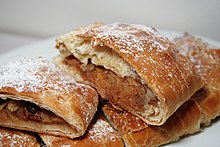Zavitek: Razlika med redakcijama
Nova stran z vsebino: {{v delu}} thumb|Jabolčni zavitek '''Zavitek''' (pogovorno ''štrudelj'') je jed, pripravljena iz listnatega ali vlečenega testa z nadevom. Lahko je sl... |
(ni razlike)
|
Redakcija: 20:32, 3. julij 2011
Ta članek je za krajši čas rezerviran, saj ga namerava eden izmed sodelavcev v večji meri preurediti. Prosimo vas, da strani v tem času ne spreminjate, saj bi lahko prišlo do navzkrižja urejanj. Če je iz zgodovine strani razvidno, da je zadnjih nekaj dni ni spreminjal nihče, lahko to predlogo odstranite. |
Zavitek (pogovorno štrudelj) je jed, pripravljena iz listnatega ali vlečenega testa z nadevom. Lahko je sladek ali pa slan. Na popularnosti je začel pridobivati v 18. stoletju na območju Habsburške monarhije.

Čeprav je zavitek najpogosteje povezan z avstrijsko kuhinjo, je nacionalna jed večih narodov znotraj bivše monarhije.
Najstarejši zapisani recept je iz 1696, nahaja pa se na Dunajski mestni knjižnici (Wiener Stadtbibliothek).[1] Sama osnova jedi (listnato testo) izvira iz Bizanca ali Bližnjega vzhoda (baklava).[2]
Poimenovanje
V Sloveniji pogovorno zavitek poimenujemo z nemško tujko štrudl (Strudel). Na Hrvaškem zavitek imenujejo štrudla ali štrudel, na Češkem závin ali štrúdl[3], na Slovaškem štrúdľa ali závin, v Romuniji ștrudel, Srbiji štrudla ali savijača, na Madžarskem pa rétes. Zavitek je popularen tudi v ostalih bivših republikah Jugoslavije.
Peka
Najbolj poznan je jabolčni zavitek, sledi pa mu sirov (pripravljen iz skute)[4]. The best-known kinds of strudel are Apfelstrudel (German for apple strudel) and Topfenstrudel (with sweet soft quark cheese, in German Topfen cheese), followed by the Millirahmstrudel (Milk-cream strudel, Milchrahmstrudel). In Slovenia, cottage cheese is used instead of quark.[5] Other strudel types include sour cherry (Weichselstrudel), sweet cherry, nut filled (Nussstrudel), Apricot Strudel, Plum Strudel[6] and poppy seed strudel (Mohnstrudel) or raisins.[7] There are also savoury strudels incorporating spinach, cabbage, pumpkin, and sauerkraut,[8] and versions containing meat fillings like the (Lungenstrudel) or (Fleischstrudel).
Traditional Austrian Strudel pastry is different from strudels served in other parts of the world that are often made from filo or puff pastry. The traditional Strudel pastry dough is very elastic. It is made[9] from flour with a high gluten content, egg, water, and butter with no sugar added. The dough is worked vigorously, rested, and then rolled out and stretched by hand very thinly. Pertaining to anecdotes, purists say, it should be so thin that a newspaper can be read through it.[10] A legend has it that the Austrian Emperor's perfectionist cook decreed that it should be possible to read a love letter through it. The thin dough is laid out on a tea towel, and the filling is spread on it. The dough with the filling on top is rolled up carefully with the help of the towel and baked in the oven.
References
- ↑ im 1696 erschienenen „Koch-Puech“ (vgl. Maier-Bruck 1993), welches sich im Bestand der Wien-Bibliothek im Rathaus befindet
- ↑ Über die Türken kam der Strudel dann nach Ungarn. Über Ungarn kam dann der Strudel nach Wien und eroberte von hier aus schließlich die ganze Welt.
- ↑ recepty/závin
- ↑ Skutin zavitek
- ↑ Cottage Cheese Strudel
- ↑ Hungarian Strudel varieties
- ↑ June Meyers Authentic Hungarian Heirloom Recipes Cookbook
- ↑ Gundel, Karoly (1992). Gundel's Hungarian cookbook. Budapest: Corvina. ISBN 963-13-3600-X. OCLC 32227400.page 127
- ↑ Real Homemade Strudel Dough
- ↑ der Teig muss so dünn sein, dass die Köchin einen darunter liegenden Liebesbrief lesen kann oder der Wirt die Zeitung